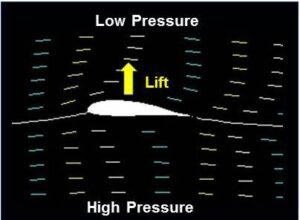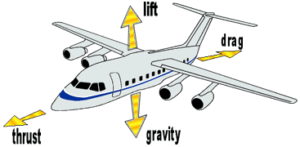How Do Airplanes Stay In The Air?
Have you ever wondered how airplanes manage to stay up in the sky, defying gravity? It’s a question that has fascinated scientists, engineers, and aviation enthusiasts for years. The remarkable ability of these massive machines to soar through the skies is made possible by the principles of physics.
Two main theories, Bernoulli’s principle and Newton’s third law of motion, lie at the heart of understanding how airplanes fly. While both theories provide valuable insights into lift generation, they also have their strengths and limitations. In this discussion, we’ll look into these theories, exploring why they work, where they fall short, and how they help us grasp the dynamics of flight.
Bernoulli’s Principle
Bernoulli’s principle offers a compelling explanation for lift generation in airplanes. According to this principle, the curved shape of the wing leads to variations in airflow speed over its surface.

As air flows over the curved upper surface, it must travel a longer distance in the same amount of time compared to the air flowing along the flatter bottom surface. This variation in airflow speed results in lower air pressure above the wing and higher pressure below it, creating a pressure difference that generates lift.
Why does it Work?
Bernoulli’s principle accurately describes the relationship between airflow speed and pressure, providing a clear mechanism for lift generation. Empirical evidence, including wind tunnel tests and real-world flight data, supports the correlation between airflow speed, pressure distribution, and lift.
Why Doesn’t It Work?
Bernoulli’s principle alone does not fully account for all aspects of lift generation. It overlooks factors such as the angle of attack and circulation around the wing, which significantly influence lift. It does not explain why airplanes can still generate lift with flat wings or when flying inverted, where the curved upper surface is now on the bottom.
Newton’s Third Law of Motion
Newton’s third law of motion provides an alternative explanation for lift generation based on the principle of action and reaction. According to this law, the wing pushes air downward as it moves forward, and in reaction, the air molecules exert an equal and opposite force upward on the wing, resulting in lift.

Why does it Work?
Newton’s third law offers a straightforward explanation for lift generation, applicable to all wing shapes and orientations. It provides a universal principle of physics that applies to all moving objects, including airplanes.
Why Doesn’t It Work?
While Newton’s third law accounts for the action-reaction principle, it does not provide insights into the specific mechanisms that lead to lift or the pressure distribution around the wing. It does not explain why certain wing shapes or angles of attack are more efficient at generating lift than others, which is crucial for aircraft design and optimization.
In reality, the process of lift generation involves a combination of Bernoulli’s principle, Newton’s third law, and other factors such as wing design, airflow dynamics, and viscosity of the air. While each theory has its strengths and weaknesses, together they contribute to the marvel of flight and the advancement of aviation technology.
Engineers and aerodynamicists use computational models, wind tunnel testing, and real-world flight data to develop a comprehensive understanding of lift and design aircraft that can efficiently and safely navigate through the air.







